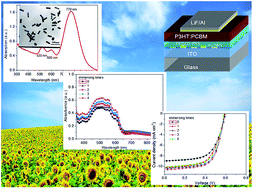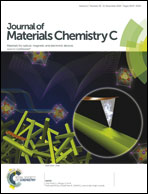Plasmonic-enhanced polymer photovoltaic cells based on Au nanoparticles with wide absorption spectra of 300–1000 nm
Abstract
Bone-like Au nanoparticles (NPs) along with a small number of by-products of nanorods, nanocubes and other irregular shapes were synthesized using a seed-mediated growth approach. The mixed Au NPs generate a very wide absorption spectra of 300–1000 nm with three main absorption peaks at 520, 600, and 770 nm, extending to the main absorption, cut-off and transparence region of the poly(3-hexylthiophene) (P3HT) and [6,6]-phenyl-C61-butyric acid methylester (PCBM) active layer. The mixed Au NPs were attached onto the ITO anode via a self-assembly method, and then P3HT:PCBM-based polymer photovoltaic cells (OPVs) were fabricated. The short-circuit current density and power conversion efficiency are significantly enhanced by 18.6% and 24.2% respectively, accompanied by the optimization of NPs distribution density. Optical, electrical, and morphological changes with the incorporation of Au NPs in the cells were thoroughly analyzed, and the results demonstrated that the cell performance improvement is mainly attributed to a synergistic reaction, including both the localized surface plasmon resonance- and scattering-induced absorption enhancement of the active layer, Au NPs-induced hole extraction ability enhancement, and large interface roughness-induced efficient exciton dissociation and hole collection.


 Please wait while we load your content...
Please wait while we load your content...